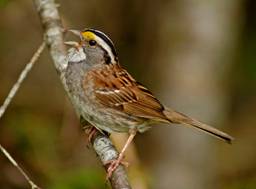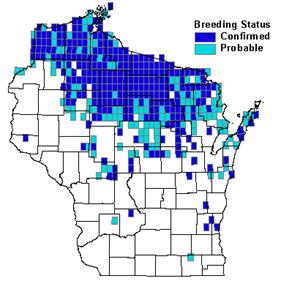

Status/Protection
- Global Rank: G5 Key to global and state ranks
- State Rank: S4B, SZN
- WBCI Priority: PIF
Population Information
The Federal BBS information can be obtained at http://www.mbr-pwrc.usgs.gov/bbs/bbs.html by clicking on Trend Estimates and selecting the species in question. All estimates are for time period (1966-2005).
- Federal Breeding Bird Survey: significant decline
- Federal Breeding Bird Survey (WI): stable
- Federal Breeding Bird Survey (BCR 23): stable
- Federal Breeding Bird Survey (BCR 12): stable
- Chequamegon National Forest Bird Survey (NRRI): significant decline (1992-2004)
- WSO Checklist Project: significant increase (1983-2007)
Life History
- Breeding Habitat: Open Bog, Black Spruce, Swamp Conifer-Balsam Fir, Alder Thicket, White Cedar, second growth mixed upland forests.
- Nest: Cup, in shrub, up to 1m (3ft.) above ground (Ehrlich et al. 1988).
- Nesting Dates: Early May to early July (WSO 1995).
- Foraging: Ground glean, foliage glean, hawks (Ehrlich et al. 1988).
- Migrant Status: Short-distance migrant.
- Habitat use during Migration: Shrubs, thickets, woodland edge, willows, dogwoods; also in urban and suburban areas (Falls and Kopachena 1994, Robbins 1991).
- Arrival Dates: Mid April to late May (Robbins 1991).
- Departure Dates: Late August to early November, although some individuals winter in Wisconsin (Robbins 1991).
- Winter Range: Primarily southeastern U.S. but some north to New York, Michigan, and Wisconsin (Robbins 1991, Falls and Kopachena 1994).
- Winter Habitat: Shrubby thickets, woodland edge, parks, gardens, fencerows (Robbins 1991, Falls and Kopachena 1994).
Habitat Selection
The White-throated Sparrow breeds in coniferous and mixed forests, lowland conifer bogs, and swamps (Falls and Kopachena 1994). In Wisconsin it is especially common in spruce bogs in the northern part of the state, and in openings of recently-harvested forests (Robbins 1991). The majority of nests are built on or near the ground, but occasionally as high as 1m above ground in a low shrub or small spruce. Nests are well-hidden by low vegetation, often under old ferns, next to stumps, or in patches of blueberry (Robbins 1991, Falls and Kopachena 1994). Nests are cups, built of grasses, twigs, conifer needles, and hair (Falls and Kopachena 1994). In the Nicolet National Forest, Howe et al. (1996) reported that the White-throated Sparrow preferred lowland conifer and balsam fir/spruce forest types and avoided immature and mature northern hardwood types.
Habitat Availability
In Wisconsin, the White-throated Sparrow occurs in northern mesic forest, northern swamps and bogs, pine forest, alder and shrub carr, in the more “closed” or “nearly forest” examples of pine barrens, and boreal forest communities (Hoffman 1989, Hoffman and Mossman 1990, Mossman et al. 1990, Mossman and Epstein 1991, Hoffman and Mossman 1993). This fairly wide choice of habitats translates into good conditions for the White-throated Sparrow in Wisconsin, and it seems populations are reasonably stable at the present time. Ecological Landscapes in Wisconsin with the highest populations of this species include the Northwest Lowlands, North Central Forest, Northern Highland, and Northeast Sands. Within these units, the Chequamegon/Nicolet National Forest, Northern Highland/American Legion State Forest, Douglas, Iron, Langlade, and Marinette County Forests appear to be important breeding areas. Populations are at lower levels in central Wisconsin with scattered concentrations of breeding birds in Door, Clark, Eau Claire, Jackson, Marathon and Shawano counties, mostly associated with county forests or state wildlife management areas. In southern Wisconsin, habitat is much more limited, with very few breeding records, except in a few areas such as the Baraboo Hills and Kettle Moraine State Forest.
Population Concerns
The White-throated Sparrow is an abundant species in the boreal forest of Canada and a common breeder in northern Wisconsin. In northern Ontario and northern Quebec, it is the most abundant bird species (Falls and Kopachena 1994). Declines were evident in Canada during the 1960s through the late 1980s but an increase was noted during the 1990s (Falls and Kopachena 1994). In the Nicolet and Chequamegon National Forests, the White-throated Sparrow was the seventh and ninth most common bird species, respectively, in point surveys (Howe et al. 1996). Although range-wide and regional Breeding Bird Survey (BBS) data indicate declining trends, Wisconsin BBS data shows relative stability. However, a small number of routes are used for the Wisconsin analysis (see Population Information, above).
Recommended Management
Conservation of White-throated Sparrow and other common northern forest birds in Wisconsin is dependent upon maintaining large blocks of forests with a variety of age classes and forest types. Semi-open conifer wetlands (i.e., bogs) in northern Wisconsin provide important breeding habitat and need to be protected from significant changes. Forest management practices can be used to create habitat for White-throated Sparrows. This species is associated with harvested areas in riparian forest stands (Hanowski et al. 2003). Natural disturbances create openings within forests (Niemi et al. 1998), as does logging. This is beneficial for White-throated Sparrow, which uses gaps and openings within forests (Falls and Kopachena 1994). Large-scale cutting (and consequently the larger area “gaps” created) may have a negative effect on populations whether for forestry or agricultural expansion. Regeneration of forests can also negatively affect White-throated Sparrow numbers if it results in more complete closure of the canopy. Ideal conditions for this species are created with numerous small forest openings with dense, low vegetation (Falls and Kopachena 1994). It responds favorably when some conifers are left unharvested. Forest management that utilized both full tree and cut-to-length harvest techniques seemed to have little effect on White-throated Sparrow in riparian plots (Hanowski et al. 2003).
Research Needs
Additional research on the evolutionary biology of the White-throated Sparrow is suggested. Although this species continues to be one of the most abundant coniferous forest birds, limiting factors are not well-known. More work needs to be done on site fidelity, and possible differential mortality of “white-striped” females and “tan-striped” males between time of fledging and time of breeding is puzzling (Falls and Kopachena 1994).
Information Sources
NRRI species account http://www.nrri.umn.edu/mnbirds/accounts/WTSPa2.htm
Chequamegon NF bird survey map http://www.nrri.umn.edu/mnbirds/accounts/WTSPm2.htm
Nicolet NF bird survey map http://www.uwgb.edu/birds/nnf/species/WTSP.htm
NRRI trend analysis http://www.nrri.umn.edu/mnbirds/speciestrends.htm
References
- Ehrlich, P.R., D.S. Dobkin, and D. Wheye. 1988.The birders handbook: a field guide to the natural history of North American birds. Simon & Schuster, Inc. New York.
- Falls, J. B. and J. G. Kopachena. 1994. White-throated Sparrow. The Birds of North America 128:1-30.
- Hanowski J., G. Niemi, N. Danz, and J. Lind. 2003. Breeding bird response to riparian forest harvest and harvest equipment. Forest Ecology and Management 174(1-3): 315-328.
- Hoffman. R.M. 1989. Birds of Wisconsin northern mesic forests. Pass. Pigeon 51(1): 97-110.
- Hoffman, R.M., and M.J. Mossman, 1990. Birds of northern Wisconsin pine forests. Pass. Pigeon 52(4): 339-356.
- Hoffman, R.M., and M.J. Mossman. 1993. Birds of Wisconsin’s northern swamps and bogs. Pass. Pigeon 55(2): 113-137.
- Howe, R.W., G. Niemi and J.R. Probst. 1996. Management of western Great Lakes forests for the conservation of neotropical migratory birds. Pages 144-167 in F.R. Thompson, III, ed. Management of midwestern landscapes for the conservation of neotropical migratory birds. U.S. For. Serv. Gen. Tech. Rep. NC-187. North Central For. Exp. Sta., St. Paul, MN.
- Mossman, M.J., E. Epstein, and R.M. Hoffman, 1990. Birds of Wisconsin boreal forests. Pass. Pigeon 52(2): 153-168.
- Mossman. M.J., and E. Epstein. 1991. Birds of Wisconsin pine and oak barrens. Pass. Pigeon 53(2): 137-163.
- Niemi, G., J. Hanowski, P. Helle, R. Howe, M. Mönkkönen, L. Venier, and D. Welsh. 1998. Ecological sustainability of birds in boreal forests. Conservation Ecology [online] 2(2):17. http://www.consecol.org/vol2/iss2/art17
- Robbins, S. D. 1991. Wisconsin birdlife: population & distribution, past & present. Univ. of Wisconsin Press, Madison, WI.
- Temple, S.A., J.R. Cary, and R.Rolley. 1997. Wisconsin birds: a seasonal and geographical guide. Second edition. Univ. of Wisconsin Press, Madison, WI.
- Wisconsin Society for Ornithology. 1995. Wisconsin breeding bird atlas; atlasing handbook 1995-1999. Wisconsin Society for Ornithology, Inc., Hartland, WI.
Contact Information
- Compiler: William P. Mueller, 414-643-7279, iltlawas@earthlink.net
- Editor: Gary Zimmer, 715-674-7505, rgszimm@newnorth.net
